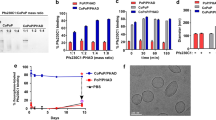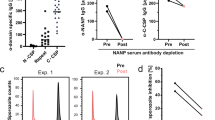Abstract
Fully effective vaccines for complex infections must elicit a diverse repertoire of antibodies (humoral immunity) and CD8+ T-cell responses (cellular immunity). Here, we present a synthetic glyco-adjuvant named p(Man–TLR7), which, when conjugated to antigens, elicits robust humoral and cellular immunity. p(Man–TLR7) is a random copolymer composed of monomers that either target dendritic cells (DCs) via mannose-binding receptors or activate DCs via Toll-like receptor 7 (TLR7). Protein antigens are conjugated to p(Man–TLR7) via a self-immolative linkage that releases chemically unmodified antigen after endocytosis, thus amplifying antigen presentation to T cells. Studies with ovalbumin (OVA)–p(Man–TLR7) conjugates demonstrate that OVA–p(Man–TLR7) generates greater humoral and cellular immunity than OVA conjugated to polymers lacking either mannose targeting or TLR7 ligand. We show significant enhancement of Plasmodium falciparum-derived circumsporozoite protein (CSP)-specific T-cell responses, expansion in the breadth of the αCSP IgG response and increased inhibition of sporozoite invasion into hepatocytes with CSP–p(Man–TLR7) when compared with CSP formulated with MPLA/QS-21-loaded liposomes—the adjuvant used in the most clinically advanced malaria vaccine. We conclude that our antigen–p(Man–TLR7) platform offers a strategy to enhance the immunogenicity of protein subunit vaccines.
This is a preview of subscription content, access via your institution
Access options
Access Nature and 54 other Nature Portfolio journals
Get Nature+, our best-value online-access subscription
$29.99 / 30 days
cancel any time
Subscribe to this journal
Receive 12 print issues and online access
$259.00 per year
only $21.58 per issue
Buy this article
- Purchase on Springer Link
- Instant access to full article PDF
Prices may be subject to local taxes which are calculated during checkout






Similar content being viewed by others
Data availability
The data that support the findings of this study are available from the corresponding author upon reasonable request.
References
Moyle, P. M. & Toth, I. Modern subunit vaccines: development, components, and research opportunities. ChemMedChem. 8, 360–376 (2013).
Seder, R. et al. Gaps in knowledge and prospects for research of adjuvanted vaccines. Vaccine 33, B40–B43 (2015).
Moon, J. J. et al. Interbilayer-crosslinked multilamellar vesicles as synthetic vaccines for potent humoral and cellular immune responses. Nat. Mater. 10, 243–251 (2011).
Lambrecht, B. N., Kool, M., Willart, M. A. & Hammad, H. Mechanism of action of clinically approved adjuvants. Curr. Opin. Immunol. 21, 23–29 (2009).
Macri, C., Dumont, C., Johnston, A. P. & Mintern, J. D. Targeting dendritic cells: a promising strategy to improve vaccine effectiveness. Clin. Transl. Immunol. 5, e66 (2016).
Alexander, J. et al. Development of experimental carbohydrate-conjugate vaccines composed of Streptococcus pneumoniae capsular polysaccharides and the universal helper T-lymphocyte epitope (PADRE®). Vaccine 22, 2362–2367 (2004).
Buonsanti, C. et al. Novel adjuvant Alum-TLR7 significantly potentiates immune response to glycoconjugate vaccines. Sci. Rep. 6, 29063 (2016).
Chen, P. et al. Dendritic cell targeted vaccines: recent progresses and challenges. Hum. Vaccines Immunother. 12, 612–622 (2015).
Burgdorf, S., Kautz, A., Böhnert, V., Knolle, P. A. & Kurts, C. Distinct pathways of antigen uptake and intracellular routing in CD4 and CD8 T cell activation. Science 316, 612–616 (2007).
Sallusto, F., Cella, M., Danieli, C. & Lanzavecchia, A. Dendritic cells use macropinocytosis and the mannose receptor to concentrate macromolecules in the major histocompatibility complex class II compartment: downregulation by cytokines and bacterial products. J. Exp. Med. 182, 389–400 (1995).
Pardee, A. D. et al. Route of antigen delivery impacts the immunostimulatory activity of dendritic cell-based vaccines for hepatocellular carcinoma. J. Immunother. Cancer 3, 32 (2015).
Tsuji, T. et al. Antibody-targeted NY-ESO-1 to mannose receptor or DEC-205 in vitro elicits dual human CD8+ and CD4+ T cell responses with broad antigen specificity. J. Immunol. 186, 1218–1227 (2011).
Ekkens, M. J. et al. Th1 and Th2 cells help CD8 T-cell responses. Infect. Immun. 75, 2291–2296 (2007).
Crotty, S. Follicular helper CD4 T cells (T FH). Annu. Rev. Immunol. 29, 621–663 (2011).
Declerck, P. J. Biologicals and biosimilars: a review of the science and its implications. Generics Biosimilars Initiat. J. 1, 13–16 (2012).
Pugholm, L. H., Petersen, L. R., Søndergaard, E. K. L., Varming, K. & Agger, R. Enhanced humoral responses induced by targeting of antigen to murine dendritic cells. Scand. J. Immunol. 82, 515–522 (2015).
Ninkovic, T. & Hanisch, F.-G. O-glycosylated human MUC1 repeats are processed in vitro by immunoproteasomes. J. Immunol. 179, 2380–2388 (2007).
Jackson, D. C., Drummer, H. E., Urge, L., Otvos, L. Jr. & Brown, L. E. Glycosylation of a synthetic peptide representing a T-cell determinant of influenza virus hemagglutinin results in loss of recognition by CD4+ T-cell clones. Virology 199, 422–430 (1994).
Liu, H. et al. Structure-based programming of lymph-node targeting in molecular vaccines. Nature 507, 519–522 (2014).
Hartmann, D., Schneider, M. A., Lenz, B. F. & Talmadge, J. E. Toxicity of polyinosinic–polycytidylic acid admixed with poly-L-lysine and solubilized with carboxymethylcellulose in mice. Pathol. Immunopathol. Res. 6, 37–50 (1987).
Singh, S. K. et al. Design of neo-glycoconjugates that target the mannose receptor and enhance TLR-independent cross-presentation and Th1 polarization. Eur. J. Immunol. 41, 916–925 (2011).
He, L.-Z., Weidlick, J., Sisson, C., Marsh, H. C. & Keler, T. Toll-like receptor agonists shape the immune responses to a mannose receptor-targeted cancer vaccine. Cell. Mol. Immunol. 12, 719–728 (2014).
Hemmi, H. et al. Small anti-viral compounds activate immune cells via the TLR7 MyD88–dependent signaling pathway. Nat. Immunol. 3, 196–200 (2002).
Campbell, G. R. & Loret, E. P. What does the structure–function relationship of the HIV-1 Tat protein teach us about developing an AIDS vaccine? Retrovirology 6, 50 (2009).
Webster, T. J. Safety of Nanoparticles (Springer, New York, 2008).
Colletier, J.-P., Chaize, B., Winterhalter, M. & Fournier, D. Protein encapsulation in liposomes: efficiency depends on interactions between protein and phospholipid bilayer. BMC Biotechnol. 2, 9 (2002).
Lee, M. H. et al. Liposomal texaphyrin theranostics for metastatic liver cancer. J. Am. Chem. Soc. 138, 16380–16387 (2016).
Yang, J., Chen, H., Vlahov, I. R., Cheng, J.-X. & Low, P. S. Evaluation of disulfide reduction during receptor-mediated endocytosis by using FRET imaging. Proc. Natl Acad. Sci. USA 103, 13872–13877 (2006).
Cox, M. A., Kahan, S. M. & Zajac, A. J. Anti-viral CD8 T cells and the cytokines that they love. Virology 435, 157–169 (2013).
Figdor, C. G., van Kooyk, Y. & Adema, G. J. C-type lectin receptors on dendritic cells and Langerhans cells. Nat. Rev. Immunol. 2, 77–84 (2002).
Iwasaki, A. & Medzhitov, R. Toll-like receptor control of the adaptive immune responses. Nat. Immunol. 5, 987–995 (2004).
Rosales, C., Lowell, C. A., Schnoor, M. & Uribe-Querol, E. Neutrophils: their role in innate and adaptive immunity 2017. J. Immunol. Res. 2017, 9748345–2 (2017).
Harding, F. A., McArthur, J. G., Gross, J. A., Raulet, D. H. & Allison, J. P. CD28-mediated signalling co-stimulates murine T cells and prevents induction of anergy in T-cell clones. Nature 356, 607–609 (1992).
Seder, R. A., Darrah, P. A. & Roederer, M. T-cell quality in memory and protection: implications for vaccine design. Nat. Rev. Immunol. 8, 247–258 (2008).
McHeyzer-Williams, L. J., Milpied, P. J., Okitsu, S. L. & McHeyzer-Williams, M. G. Class-switched memory B cells remodel BCRs within secondary germinal centers. Nat. Immunol. 16, 296–305 (2015).
Lynn, G. M. et al. In vivo characterization of the physicochemical properties of polymer-linked TLR agonists that enhance vaccine immunogenicity. Nat. Biotechnol. 33, 1201–1210 (2015).
Hoffman, S. L., Vekemans, J., Richie, T. L. & Duffy, P. E. The march toward malaria vaccines. Am. J. Prev. Med. 49, S319–S333 (2015).
Mosquirix; Common Name: Plasmodium falciparum and Hepatitis B Vaccine (Recombinant, Adjuvanted) 1–175 (CHMP, 2015).
Cohen, J., Nussenzweig, V., Vekemans, J. & Leach, A. From the circumsporozoite protein to the RTS,S/AS candidate vaccine. Hum. Vaccin. 6, 90–96 (2014).
Kester, K. E. et al. Randomized, double-blind, phase 2a trial of falciparum malaria vaccines RTS,S/AS01B and RTS,S/AS02A in malaria-naive adults: safety, efficacy, and immunologic associates of protection. J. Infect. Dis. 200, 337–346 (2009).
Coccia, M. et al. Cellular and molecular synergy in AS01-adjuvanted vaccines results in an early IFNγ response promoting vaccine immunogenicity. NPJ Vaccines 2, 95 (2017).
Tewari, K. et al. Poly(I:C) is an effective adjuvant for antibody and multi-functional CD4+ T cell responses to Plasmodium falciparum circumsporozoite protein (CSP) and αDEC-CSP in non human primates. Vaccine 28, 7256–7266 (2010).
Dockrell, D. H. Imiquimod and resiquimod as novel immunomodulators. J. Antimicrob. Chemother. 48, 751–755 (2001).
Wiley, S. R. et al. Targeting TLRs expands the antibody repertoire in response to a malaria vaccine. Sci. Transl. Med. 3, 93ra69–93ra69 (2011).
Plassmeyer, M. L. et al. Structure of the Plasmodium falciparum circumsporozoite protein, a leading malaria vaccine candidate. J. Biol. Chem. 284, 26951–26963 (2009).
Bongfen, S. E. et al. The N-terminal domain of Plasmodium falciparum circumsporozoite protein represents a target of protective immunity. Vaccine 27, 328–335 (2009).
Estey, T., Kang, J., Schwendeman, S. P. & Carpenter, J. F. BSA degradation under acidic conditions: a model for protein instability during release from PLGA delivery systems. J. Pharm. Sci. 95, 1626–1639 (2006).
Moad, G. RAFT polymerization to form stimuli-responsive polymers. Polym. Chem. 8, 177–219 (2017).
Trinchieri, G. & Sher, A. Cooperation of Toll-like receptor signals in innate immune defence. Nat. Rev. Immunol. 7, 179–190 (2007).
Hirosue, S., Kourtis, I. C., van der Vlies, A. J., Hubbell, J. A. & Swartz, M. A. Antigen delivery to dendritic cells by poly(propylene sulfide) nanoparticles with disulfide conjugated peptides: cross-presentation and T cell activation. Vaccine 28, 7897–7906 (2010).
Silvie, O. et al. Hepatocyte CD81 is required for Plasmodium falciparum and Plasmodium yoelii sporozoite infectivity. Nat. Med. 9, 93–96 (2003).
Rénia, L. et al. A malaria heat-shock-like determinant expressed on the infected hepatocyte surface is the target of antibody-dependent cell-mediated cytotoxic mechanisms by nonparenchymal liver cells. Eur. J. Immunol. 20, 1445–1449 (1990).
Acknowledgements
We thank the Flow Cytometry Core Facility of EPFL for technical assistance, and Dr E. Simeoni of EPFL for discussion of the research and guidance on animal work. D.S.W. was supported by a fellowship from the Whitaker Foundation. We would like to thank PATH for donating the CSP used in our studies. This study was supported by the School of Life Sciences, EPFL, and the University of Chicago. This work benefited from equipment and services from the CELIS cell culture core facility (Institut du Cerveau et de la Moelle Epinière, Paris), a platform supported through the ANR grants ANR-10-IAIHU-06 and ANR-11-INBS-0011-NeurATRIS. We are particularly grateful to D. Akbar for his assistance regarding automated fluorescence.
Author information
Authors and Affiliations
Contributions
J.A.H. and M.A.S. oversaw all research; D.S.W. conceptualized materials; D.S.W., M.M.R. and R.W. performed the synthesis; D.S.W., S.H. and J.A.H designed animal studies; D.S.W., S.H., M.A.S.B., L.J., G.D. and X.Q.T. performed animal studies; S.H., L.J., D.S.W. and M.K. designed and carried out in vitro studies; D.M., J.-F.F. and L.B.R. designed hepatic invasion studies; J.-F.F. and L.B.R. carried out hepatic invasion studies; D.S.W., S.H. and J.A.H. wrote the manuscript; all authors proofread the manuscript.
Corresponding author
Ethics declarations
Competing interests
The University of Chicago has filed for patent protection on the p(Man-TLRx) delivery platform, and J.A.H., S.H. and D.S.W. are named as inventors on these patents.
Additional information
Publisher’s note: Springer Nature remains neutral with regard to jurisdictional claims in published maps and institutional affiliations.
Supplementary information
Supplementary Information
Supplementary Figures 1–34, Supplementary Methods, Supplementary References 1–2
Rights and permissions
About this article
Cite this article
Wilson, D.S., Hirosue, S., Raczy, M.M. et al. Antigens reversibly conjugated to a polymeric glyco-adjuvant induce protective humoral and cellular immunity. Nature Mater 18, 175–185 (2019). https://doi.org/10.1038/s41563-018-0256-5
Received:
Accepted:
Published:
Issue Date:
DOI: https://doi.org/10.1038/s41563-018-0256-5
This article is cited by
-
Revolutionizing lymph node metastasis imaging: the role of drug delivery systems and future perspectives
Journal of Nanobiotechnology (2024)
-
The therapeutic potential of immunoengineering for systemic autoimmunity
Nature Reviews Rheumatology (2024)
-
Self-adjuvant Astragalus polysaccharide-based nanovaccines for enhanced tumor immunotherapy: a novel delivery system candidate for tumor vaccines
Science China Life Sciences (2024)
-
Malaria therapeutics: are we close enough?
Parasites & Vectors (2023)
-
Hyaluronan as an immunological adjuvant: a novel application for an ancient molecule
Cellular & Molecular Immunology (2023)



